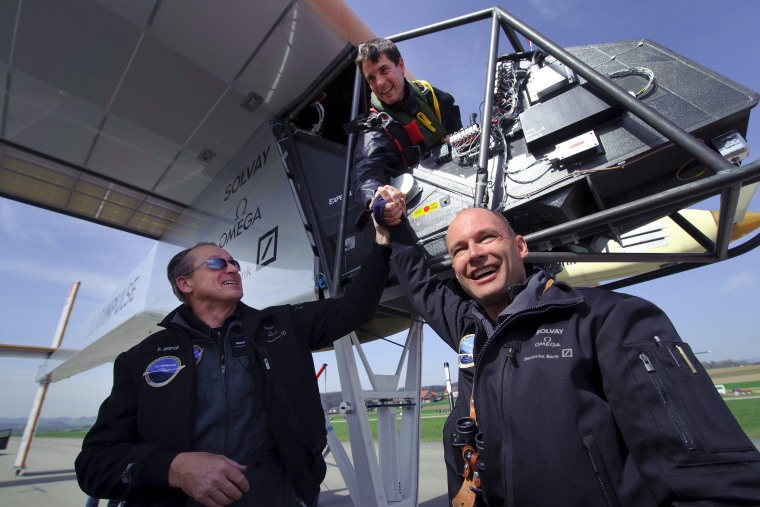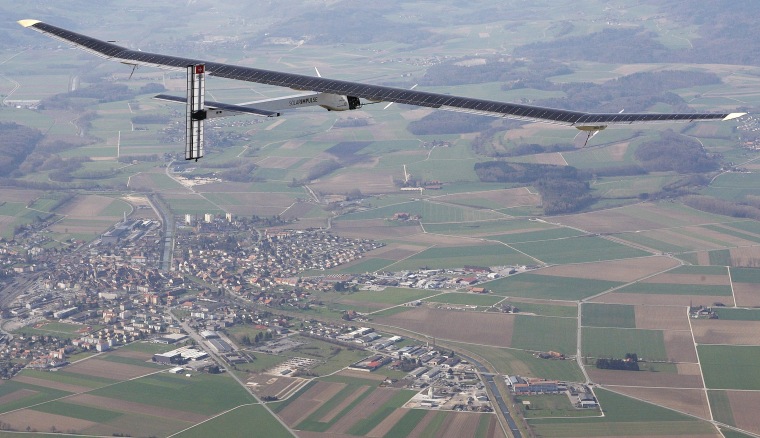A solar plane with wings as wide as a 747 and the power of a small motorboat took to the skies for the first time Wednesday, cruising a mile high at low speeds for nearly 1½ hours in a step toward becoming the first sun-powered aircraft to circle the world.
In its maiden test flight, "Solar Impulse" — designed by Swiss adventurer Bertrand Piccard's team — completed a series of turns, slip maneuvers and bank angles reaching 5 degrees. Most importantly, it proved able to take off and land.
The team plans to fly it around the world in 2012, the goal being to show that renewable energy can replace fossil fuel.
"There has never been an airplane of that kind that could fly — never an airplane so big, so light, using so little energy," said Piccard, who in 1999 copiloted the first nonstop round-the-globe balloon flight. "So there were huge question marks for us."
At a military airport in the Swiss countryside, the plane lifted off at a speed no faster than 28 mph after only a short acceleration on the runway. It slowly gained altitude above the green and beige fields, and disappeared eventually into the horizon as villagers watched from the nearest hills.
The descent was even slower, as the sun-powered craft hovered ahead of the runway for a couple of minutes before touching down to cheers from spectators.
The weather for the maiden flight was sunny, and there was little wind.
Earlier hops
"Flea-hop" tests have been made since December, taking the plane no higher than 2 feet in altitude and 1,000 feet in distance. A night flight is planned before July, and then a new plane will be built based on the results of those tests.
"The goal is to fly day and night with no fuel, the goal is to demonstrate the importance of renewable energies, to show that with renewable energies we can achieve impossible things," said Piccard, who monitored but didn't pilot Wednesday's test run.
Test pilot Markus Scherdel said the plane isn't designed for maneuvers, but showed it was able to take off and land safely with handling like a passenger jet.
"Everything worked as it should," he said.
Using almost 12,000 solar cells, rechargeable lithium batteries and four electric motors, Piccard and co-pilot Andre Borschberg plan to take the plane around the world with stops to allow them to switch over and stretch after long periods in the cramped cockpit.
The entire aircraft weighs about 3,500 pounds, about the same as a midsized car.
The batteries allow the plane to fly day or night, but the circumnavigation will take time.
With the motors providing only 10 horsepower each, the plane will fly almost like a moped in the sky, at an average flight speed of 44 mph. The trip will be split up into five stages — keeping the plane in the air for up to five days at a time — with the stopovers also allowing the team to show off their creation.
Solar flight isn't new but Piccard's project is the most ambitious.
In 1980, the fragile Gossamer Penguin ultra-lightweight experimental solar plane flew short demonstration flights with one pilot on board. A more robust project called the Solar Challenger flew one pilot from France to England in a five-hour-plus trip in 1981.
Solar plane technology recalls the early days of manned flight, and the slow ascent of the Solar Impulse was somewhat reminiscent of the Wright brothers pioneering experiments over a century ago.
"The first crucial question was: Do we have enough power to fly?" said Borschberg. "The second crucial thing was: are we capable of landing this airplane, is it controllable?"
"It was two hours of deep emotion," he added, calling it the high point of seven years of work on the project. "The airplane has landed but we have not yet landed."
5,500 feet reached
Borschberg followed the flight in a helicopter; below waited numerous people involved with the project and Piccard, who comes from a long line of adventurers. His late father Jacques plunged deeper beneath the ocean than any other man, and grandfather Auguste was the first man to take a balloon into the stratosphere.

Solar Impulse said the flight reached an altitude of 5,500 feet. After landing, Scherdel emerged from the cockpit with his arms raised and the team broke open bottles of champagne.
"It went so silent, so soft," Piccard said.
He acknowledged the role of good weather, however.
Because the solar panels are needed for day flying and for charging the 880-pound lithium batteries that power the plane by night, it relies on sunshine, and Piccard said his team will have to scrupulously monitor conditions and divert routes to avoid storms.
Personnel on the ground will also have to be able to keep up with the plane as it follows the best weather to provide service at each stop, he said.
"Round-the-world will seem impossible until we do it." Piccard said. "Today is an absolutely incredible milestone."
